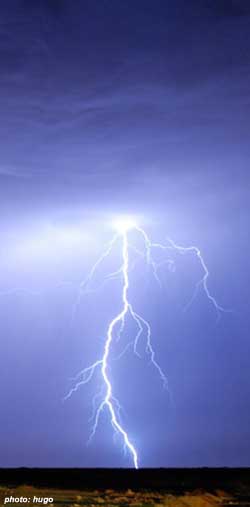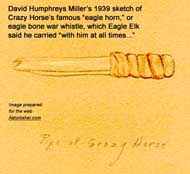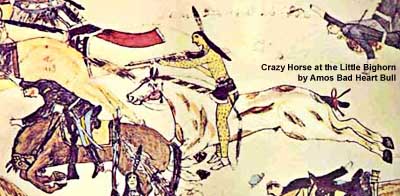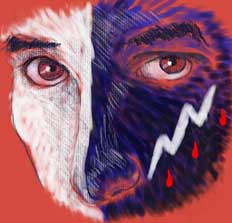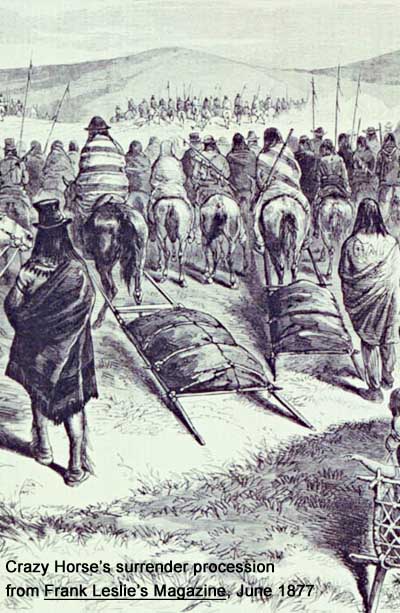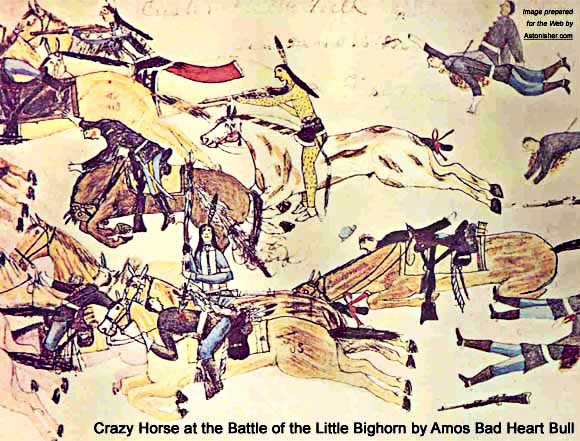Bruce Brown's 100 Voices... Crazy Horse's Story of the Battle
Although it contains the closest thing we have to Crazy Horse's version of what happened at the Battle of the Little Bighorn, Crazy Horse never actually spoke with the Chicago Times reporter who wrote the story. Instead, he communicated through a spokesman, Sioux war chief Horned Horse. Imagine it. Crazy Horse -- known as Tasunka Witko ("His Horse Is Crazy") to the Sioux -- rode into Fort Robinson, Nebraska, on May 6, 1877 at the head of a procession of people and ponies that stretched on for miles, but somehow he managed to escape capture by the American press! It's as if he was never there -- at his own surrender -- but that was typical of Crazy Horse. In fact, Crazy Horse is the only great figure in American history who never allowed his soul to be captured, as the Sioux conceived it, meaning he never allowed his image to be captured in life, either by photograph or artist's hand. The only evocative eye-witness description of Crazy Horse that appeared in the American media during his lifetime was an anonymous New York Sun reporter's 1877 observation that "his eyes are exceedingly restless and impress the beholder fully as much as does his general demeanor." |
||||||||||||||
Crazy Horse could make a whole battle turn on the flash of a mirror in his hand as General George Crook learned at the Battle of the Rosebud, or the scream of his eagle bone war whistle as General Nelson Miles learned at the Battle of Wolf Mountain. AT THE LITTLE BIGHORN, Crazy Horse led his crack troops in charges that shattered the defenses of first Reno and then Custer. Iron Hawk and Standing Bear described how Crazy Horse's first flanking charge of the battle "broke Reno's left wing" in the timber and sent his men fleeing for their lives, and Flying Hawk described how Crazy Horse personally rode among the American soldiers and "killed a lot of them with his war-club." Then after he disengaged from Reno, Crazy Horse led his combined Sioux and Cheyenne force to flank Custer's retreating men. Flying Hawk described how Crazy Horse "shot them [American soldiers] as fast as he could load his gun" while he studied the situation. Then He Dog said Crazy Horse led a charge which split Custer's right flank on the ridge above the river. In the deadly melee that followed, Red Feather described how Crazy Horse rode between the two split portions blowing on his wild, unearthly Eagle Horn. Crazy Horse drew withering fire but escaped untouched.
Crazy Horse was chosen commander-in-chief of the joint Sioux and Cheyenne army the next day -- as he was on the Rosebud nine days before -- and according to Short Bull, Crazy Horse led the Indians' stately withdrawal from the Little Bighorn witnessed by Medal of Honor winner Charles Windolf. THE BATTLE of the Little Bighorn is often viewed as the apogee of Crazy Horse's military career, but actually the Battle of the Rosebud eight days prior was probably his greatest moment in the American wars of imperial conquest. At the Little Bighorn, there was no Indian commander-in-chief. The Indians had not planned to fight; they simply reacted to Custer's unprovoked attack. So Crazy Horse was one of many more-or-less equal corps commanders that day, including Gall, Crow King, Red Horse, Rain In The Face, He Dog, Hump, Big Road, Spotted Elk, Lame White Man, Two Moon, and many other notables. See Crazy Horse at the Little Bighorn for more info. On the Rosebud, however, Crazy Horse was commander-in-chief of the combined Sioux / Cheyenne force and planned the first strike. He and his men rode all night to catch General George Crook in the Valley of the Rosebud, and everyone who saw the Indians' initial charge that day -- 1,500 fiercely painted warriors of the "best cavalry soldiers on earth" coming at full gallop and full cry -- never forgot it for the rest of their lives. It was a true "holy shit" moment because Crazy Horse caught Crook's main force off their horses at rest. Some had even loosened their saddle girths. Here are John Bourke, John Finerty and Henry Lemly's eye-witness accounts of that moment. Crook survived Crazy Horse's opening charge on June 17, 1876 -- thanks to the fierce valor of his Crow and Shoshoni scouts -- but Crazy Horse's deft use of the fleet and supremely mobile Sioux and Cheyenne cavalry -- controlled by mirror flash from higher ground -- ultimately secured a grand strategic victory for the free Sioux and Cheyenne, eliminating Crook's army from the subsequent action on the Little Bighorn, and setting up everything that was to come with Custer. See Crazy Horse at the Rosebud for more info.
After fighting General Nelson Miles to a draw in his last battle at Wolf Mountain in January 1877, Crazy Horse decided that following Sitting Bull to Canada would only inflict more hardship on his people. So he surrendered, riding into Fort Robinson, Nebraska, with nearly 1,000 followers on May 6, 1877. Crazy Horse's surrender was the raison for the story below, which originally ran in the May 7, 1877 Chicago Times. Barely four months later, the U.S. Army murdered Crazy Horse while he was in "protective custody," part of a drumbeat of atrocities and war crimes committed by invading American soldiers against Native Americans that foreshadowed the atrocities and war crimes committed by invading American soldiers against native populations in Afghanistan and Iraq and Pakistan and Syria a century and a half later. In fact, this is a major theme in American history. This is how America was made, and how America made -- and continues to make -- mujahidin bent on fighting America to the death, for Crazy Horse was a holy warrior as much as any Islamic jihadist, possessing the combined dream power of all the elements, as the Sioux understood them. "When he rode into battle," Kingsley M. Bray wrote in Crazy Horse: A Lakota Life, "Crazy Horse was not simply a naked warrior with a curious paint design: his being crackled with the awesome destructive powers of the total cosmos."
CRAZY HORSE SPEAKS THE CUSTER MASSACRE AN INDIAN'S DESCRIPTION OF THE BATTLE Telegram to Chicago Times from Camp Robinson, Nebraska.
The attack was made on the village by a strong force at 11 o'clock in the morning, at the upper end of the village. This was the force commanded by Maj. Reno, and very shortly afterward the lower end of the village was attacked by another strong force, that commanded by Custer. The Village Was Divided into seven different bands of Indians, each commanded by a separate chief and extended in nearly a straight line. The bands were in the order mentioned below, commencing from the lower end where Custer made the attack. First, the Uncpapas, under Sitting Bull; second, the Ogalallas, under Crazy Horse; third, the Minneconjous, under Fast Bull; fourth, the Sans Arcs, under Red Bear; fifth, the Cheyennes, under Ice Bear, their two principal chiefs being absent; sixth, the Santees and Yanktonias, under Red Point, of the Santees; seventh, the Blackfeet, under Scabby Head. The village consisted of eighteen hundred lodges, and at least four hundred wickayups, a lodge made of small poles and willows for temporary shelter. Each of the wickayups contained four young bucks, and the estimate made by Crazy Horse is that each lodge had from three to four warriors. Estimating at three made A Fighting Force of seven thousand Indians. This is the lowest estimate that can be made, for there were a good many Indians without shelter, hangers-on, who fought when called upon, and the usual number was much above seven thousand. The attack was a surprise and totally unlooked for. When Custer made his charge the women, papooses, children, and in fact all that were not fighters made a stampede in a northerly direction. Custer, seeing so numerous a body, mistook them for the main body of Indians retreating and abandoning their village, and immediately gave pursuit. The warriors in the village, seeing this, divided their forces into two parts, one intercepting Custer between their non-combatants and him, and the other getting in his rear. Outnumbering him as they did, they had him at their. mercy, and The Dreadful Massacre Ensued Horned Horse says the smoke and dust was so great that foe could not be distinguished from friend. The horses were wild with fright and uncontrollable. The Indians were knocking each other from their steeds, and it is an absolute fact that the young bucks in their excitement and fury killed each other, several dead Indians being found killed by arrows. Horned Horse represented this hell of fire and smoke and death by intertwining his fingers and saying: "Just like this, Indians and white men." These chiefs say they suffered a loss of fifty-eight killed, and over sixty wounded. From their way of expressing it, I should judge that about 60 per cent of their wounded died. While This Butchery Was Going On Reno was fighting in the upper part of the village, but did not get in so as to get surrounded, and managed to escape. They say had he got in as far, he would have suffered the same fate as Custer, but he retreated to the bluffs, and was held there until the Indians fighting Custer, comprising over half the village, could join the northern portion in besieging him. These Indians claim that but for The Timely Arrival of Gen. Terry they would have certainly got Reno. They would have surrounded and stormed him out or would have besieged and eventually captured him. From what I know of Crazy Horse I should say that he no doubt is capable of conducting a siege. In both the Rosebud fight and the Custer massacre the Indians claim he rode unarmed in the thickest of the fight invoking the blessing of the great spirit on him-that if he was right he might be victorious and if wrong that he might be killed. The Custer Myth: A Source Book of Custerania, written and compiled by Colonel W.A. Graham, The Stackpole Co., Harrisburg, PA 1953, p 62 - 65
For more information on Crazy Horse, please see the Bogus Crazy Horse Photo page, the Crazy Horse Surrender Ledger and the Winter Count of Crazy Horse's Life.
|
|
|||||||||||||




